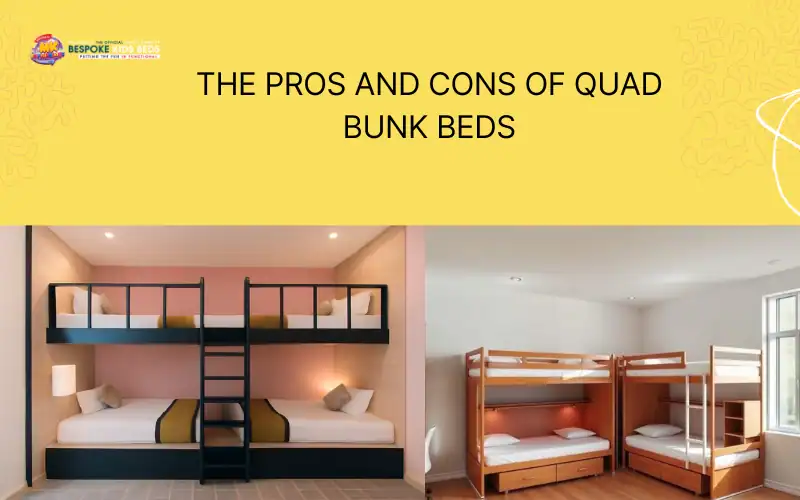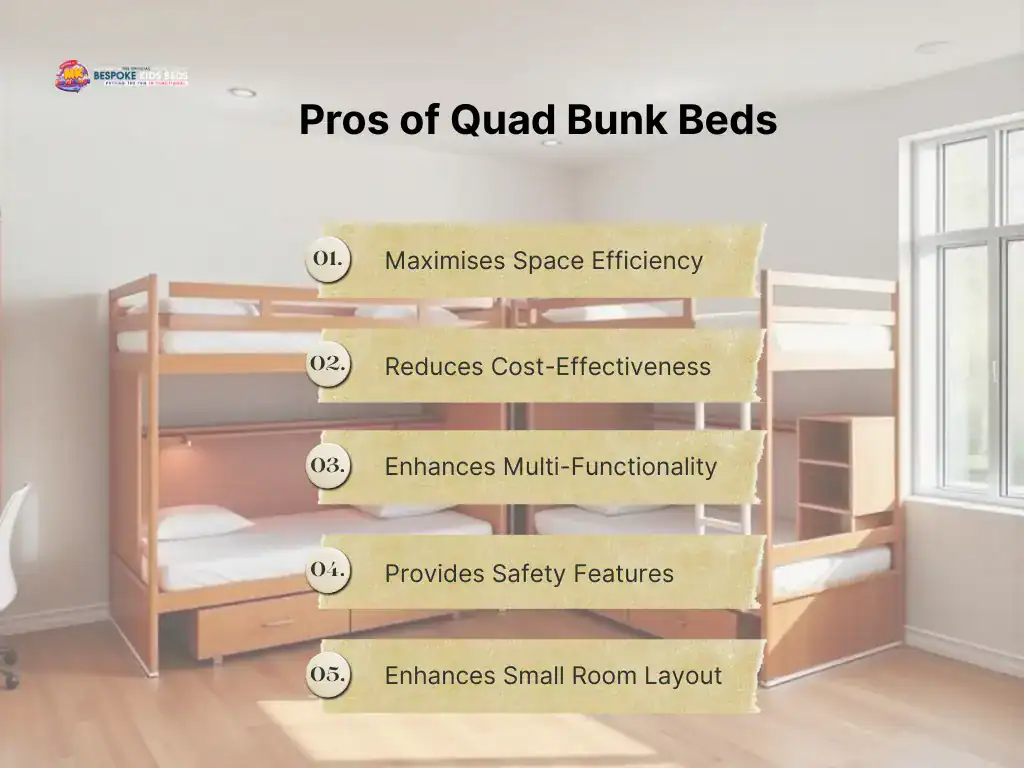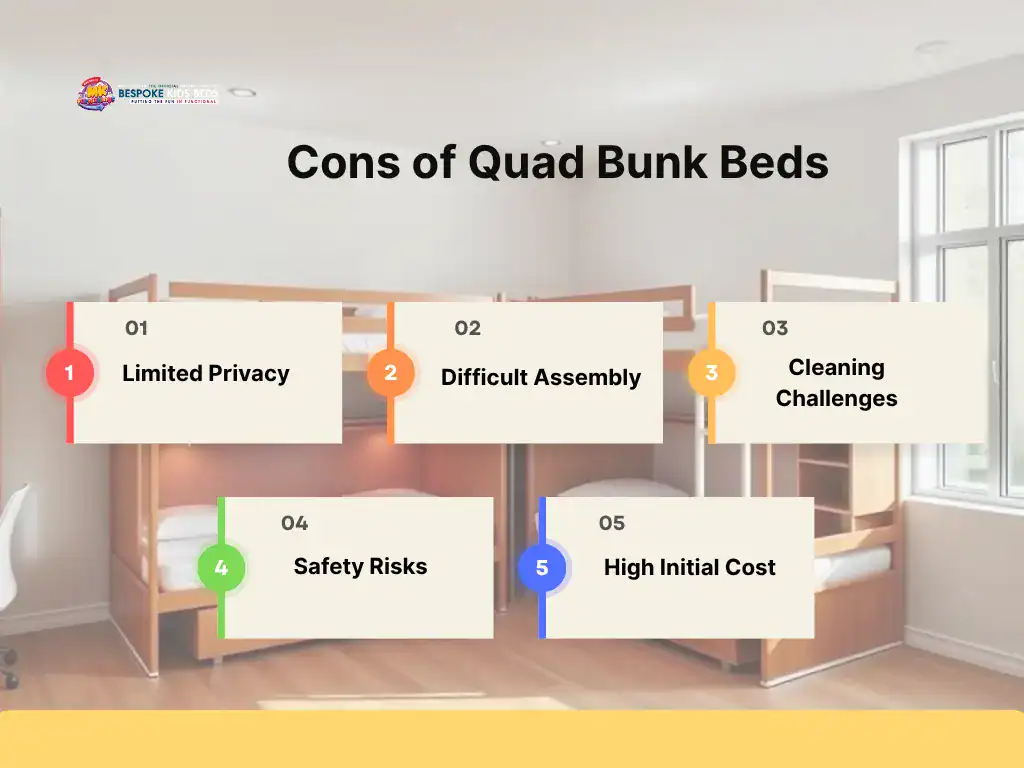
How Much Sleep Do Kids Need?
Babies need 14 to 17 hours, kindergarten aged children need 10 to 13 hours, and teenagers typically need 8 to 10 hours of total sleep.
Enjoy FREE Delivery on All Orders!

Quad bunk beds offer space efficiency, cost savings, and multifunctionality while presenting challenges like limited privacy, complex assembly, and potential safety concerns. These vertically stacked sleeping units are designed to accommodate up to four individuals and are commonly used in compact environments such as children’s rooms, dormitories, and hostels. Their core purpose is to save floor space by consolidating multiple beds into one integrated structure.
On the positive side, quad bunk beds make excellent use of vertical space, allowing more room for play, study, or storage. Many models include built-in drawers, desks, or shelves, adding functionality without occupying extra floor area. For example, a quad bunk in a shared bedroom can create enough space for a study corner, making it a valuable solution for growing families. These beds are also cost-effective, replacing the need to purchase and arrange multiple individual frames.
Yet, potential buyers should also consider the drawbacks. The open, shared structure may limit privacy for older children, while the tall, multi-layered design can pose safety concerns without proper guardrails. Additionally, installation and upkeep may be more demanding due to tighter spaces and hard-to-reach areas. The next section highlights the major advantages of quad bunk beds.

Quad bunk beds offer space efficiency, cost-effectiveness, multi-functionality, safety features, and suitability for small rooms. By stacking four sleeping units vertically, they free up valuable floor area and often include built-in storage or desks that reduce the need for additional furniture. These beds are especially practical for families with multiple children or institutions managing limited space, combining utility with thoughtful design to support compact living.
With versatile layouts like single-over-single, corner stack, or L-shape, quad bunk beds are engineered to minimise floor space while accommodating four sleepers. Measuring between 340 cm and 435 cm in width and 100 cm to 200 cm in depth, these configurations adapt to both rectangular and square room layouts. A typical L-shaped quad setup installed in a 12×10 ft room can free over 50% of the floor area, which can then be used for desks or wardrobes. Their vertical structure, with heights around 175 cm, supports standard and even lower ceiling heights, ensuring headroom is preserved for all bunk levels.
Choosing one quad bunk setup instead of four separate beds significantly reduces total furnishing costs. A standard quad unit eliminates the need for extra bed frames, storage chests, or nightstands. Each bunk supports up to 17 stone, meeting EN747-certified durability standards, which ensures the structure lasts for years without needing reinforcement or replacement. Add-ons such as integrated drawers and pull-out trundles further reduce expenses by removing the need to buy separate under-bed storage or guest bedding solutions, making it a one-time investment for families managing space and budgets.
More than just sleeping arrangements, quad bunk beds are designed to serve multiple functions within a compact footprint. Many models include built-in features like in-step drawers for storing clothes or toys, pull-out trundles for occasional guests, and optional add-ons such as shelving or fold-out desks. Customisation is another advantage, with drawer fronts available in colours like pink, grey, and blue, and headboards featuring cut-out motifs featuring stars, hearts, or butterflies, to reflect individual style. This multi-functionality helps reduce the need for separate furniture pieces, making the bed a central, organised hub for sleep, play, and daily activities.
Built from durable wood and reinforced for high-load use, these quad bunk beds meet the EN747 European Safety Standard for children’s beds. Designed with younger users in mind, they incorporate key safety features such as full-length guardrails, stair gates, and anti-slip ladder rungs to reduce the risk of falls. Frames made from hardwood or steel are rated to support up to 17 stone (238 lbs) per bunk, ensuring stability for children aged 6 and above, including teenagers. Rounded corners help prevent injuries, while optional wall-anchoring systems add extra structural security. Together, these elements create a safe and reliable sleeping solution for shared spaces.
Despite their capacity, quad bunk beds are specifically designed for space-restricted environments. Their compact vertical build, with a typical height of 175 cm, allows them to fit comfortably in rooms with low ceilings. Configurations such as corner or wall-aligned layouts make it possible to accommodate a full four-bed unit in bedrooms as small as 100 square feet. In designs like a single-over-single quad bunk, the central floor area remains open, providing space for modular furniture or carpeted play zones. Additionally, their compatibility with 3ft memory foam or hybrid mattresses ensures sleeping comfort without increasing the bed’s footprint.

Despite their advantages, quad bunk beds have notable drawbacks such as limited privacy, difficult assembly, cleaning challenges, safety risks, and high initial cost. Each of these factors may impact their practicality depending on room layout, user age, and maintenance capacity. Room-specific constraints, such as uneven walls or low-hanging fixtures, can limit viable placements. These beds also add considerable load to floors, which may be a concern in older or upper-storey rooms.
The shared structure of quad bunk beds limits personal space for each occupant, which may become increasingly problematic as children grow older. Without partitions or enclosed panels, these beds provide little sound or light separation between sleepers. As a result, differing sleep schedules, reading habits, or noise sensitivity can lead to discomfort and disturbances. This lack of privacy reduces suitability for teenagers or for use in semi-public settings such as hostels, where individual space is often valued.
Assembling a quad bunk bed is more involved than setting up a standard frame due to the complexity of its components. These include stair units, guardrails, support beams, and drawer systems, all of which require precise alignment to maintain safety and durability. In more elaborate designs, like L-shaped or corner configurations, multiple people are often needed to manage the assembly process effectively. Because of this, many buyers prefer to hire professional assembly services to avoid structural errors and ensure secure installation.
Maintaining cleanliness in a quad bunk bed can be physically demanding because of its layered design. Dust, crumbs, and debris tend to accumulate in narrow gaps between bunks, under stair drawers, and along internal frame sections. Reaching these areas often requires tools or ladders, which adds time to routine cleaning. For families with young children who frequently snack or play in bed, the effort required to keep all levels hygienic can become a consistent maintenance concern.
Although most quad bunk beds are built with guardrails and anti-slip features, their elevated structure naturally introduces some safety concerns. Children sleeping on upper levels face a risk of falling, particularly if safety protocols are not followed or if components are assembled incorrectly. Manufacturers recommend that only children over 6 years of age use the upper bunks, but even within that range, supervision is often necessary. In cases where improper mattress sizing is used, protective barriers may become less effective, increasing the chance of injury.
Investing in a quad bunk bed with integrated storage, safety features, and quality materials often involves a significant upfront cost. While the long-term value is notable, especially compared to purchasing four separate beds and storage units, the initial expense may not align with every household budget. Customisations, such as decorative cutouts or colour panels, and the addition of memory foam mattresses can quickly elevate the price. For many families, the financial commitment must be carefully weighed against available alternatives and immediate needs.
Choosing the right quad bunk bed depends on key factors like room layout and dimensions, safety and durability, multifunctionality, aesthetic appeal, and long-term use. Each of these considerations plays a critical role in determining whether a specific model will meet both current and future needs. The following sections break down these elements in detail.
Before purchasing, measure the available space, including ceiling height, floor area, and wall clearance. Most quad bunk beds range from 340 cm to 435 cm in width and 100 cm to 200 cm in depth, with an average height of 175 cm. Ensure the room allows for safe movement around the bed and access to ladders or stairs. For example, an L-shaped design might suit a square room, while a linear layout may be better for narrow spaces.
Choose a model built from strong materials like solid wood and certified to meet EN747 safety standards. Look for reinforced guardrails, secure stair gates, anti-slip steps, and smooth edges. Each bunk should safely support at least 17 stone. If the bed will be used daily or by older children, verify that all fittings are metal rather than plastic and that the base slats can withstand prolonged weight over time.
To make the most of your space, choose a model that combines multiple functions into one unit. Many quad bunk beds now include built-in storage such as under-bed drawers or in-step compartments. Some even integrate trundles or study desks, creating a hybrid solution that addresses both sleeping and daytime needs. These features minimise the need for separate furniture, which is especially useful in compact or shared rooms.
Aesthetics also play a role in choosing the right bunk bed, particularly for children’s rooms. Many models are available with custom drawer colours like pink, grey, or blue and include playful cutouts such as stars, hearts, or butterflies. These design elements not only personalise the bed but also help it blend with existing décor. Matching materials and finishes to the room’s theme creates a cohesive and inviting environment.
Investing in a bunk bed that adapts over time adds significant value. Some designs can be separated into individual beds or modified as children grow, extending their usability well beyond early years. Modular components and high-quality materials ensure that the bed can withstand years of daily use. Choosing a flexible structure helps families avoid frequent furniture changes as needs evolve.
Space-saving furniture plays a vital role in homes with multiple children or limited room dimensions, and quad bunk beds are a prime example of this design philosophy. These beds combine sleeping, storage, and study features into one compact unit, helping families make the most of every square foot. By integrating essential functions, they reduce the need for extra furniture and keep shared spaces organised.Recognising the real needs of growing families, MK Furnishing offers quad bunk beds designed specifically for compact, high-use spaces. Our collection of quad bunk beds features stair gates, anti-slip steps, and built-in storage while meeting EN747 safety standards. With sturdy construction and playful design options, these beds provide a practical and child-friendly solution for maximising shared bedrooms.
Kyle Kane
Owner
Kyle Kane is Co-Owner of MK Furnishings, a family-run business based in UK that specializes in high-quality custom kids’ bunk beds, including triple, double, single, and themed designs. Since launching the company in 2016 alongside his brother-in-law, Kyle has helped deliver and assemble thousands of beds across the UK, Ireland, and beyond. Focused on customer satisfaction, Kyle leads a hardworking team that handles every step from ordering to delivery ensuring a smooth and professional service. His commitment to quality craftsmanship and reliable support has earned MK Furnishings a strong reputation and growing customer base throughout the region.

Babies need 14 to 17 hours, kindergarten aged children need 10 to 13 hours, and teenagers typically need 8 to 10 hours of total sleep.

A mattress should be changed typically anywhere between 6 to 10 years, depending on the mattress type, quality, total usage, and the consistency of the
Fancy £50 off all orders! Enter in 50off to redeem in the coupon code section